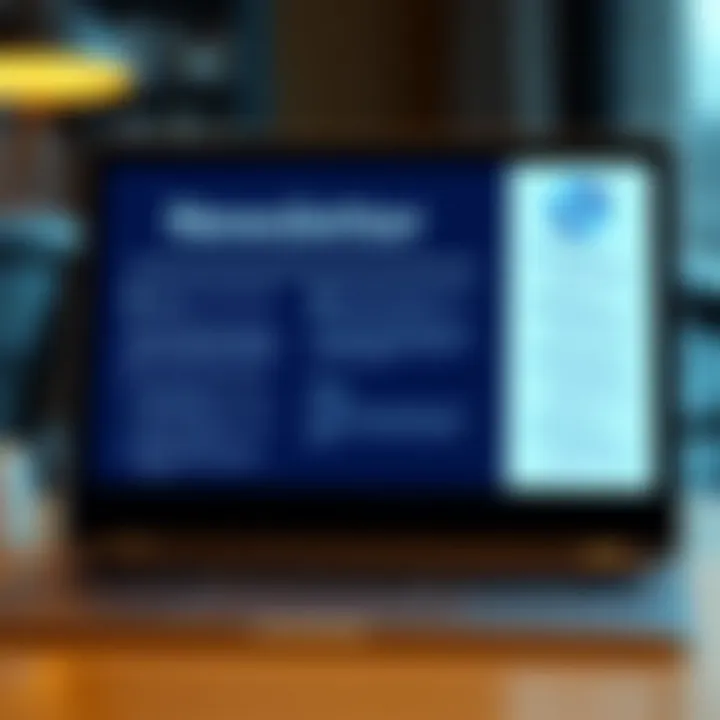Crafting a Strategic Newsletter: A Guide for Entrepreneurs


Intro
In today’s fast-paced business environment, entrepreneurs constantly look for avenues to connect with their audience. One of the most effective tools at their disposal is a well-crafted newsletter. It serves not just to inform, but to build relationships, enhance brand visibility, and ultimately drive sales. It’s like having a conversation with your audience, where they get to know you and what you stand for while you deliver valuable insights directly to their inbox.
A well-structured newsletter isn’t just a collection of updates; it should reflect the values and missions of your business. To properly harness the power of newsletters, entrepreneurs need to grasp not only the art of crafting engaging content but also the science of measuring its impact. This guide will navigate through the essentials - from understanding your audience to creating compelling content that resonates.
The initial step is recognizing the importance of newsletters in the grand scheme of business communication. Unlike social media posts, newsletters provide a dedicated space for in-depth information, personal stories, and calls to action. This direct line of communication allows you to reach your audience when they are most receptive.
Furthermore, staying ahead means being adaptable and aware of current trends. In a landscape where technology rapidly evolves, understanding that newsletters can use automation and personalization to engage readers makes all the difference. As we delve deeper, you will come to see how strategic content creation, thoughtful design, and ongoing performance analysis form the backbone of an effective newsletter strategy.
Let's explore these components more intricately.
The Purpose of a Newsletter in Business
Newsletters have emerged as a cornerstone in the toolkit of modern business communication. They are not merely vehicles for information; instead, they serve crucial purposes that can have a profound impact on various aspects of a business. At their core, newsletters facilitate communication, foster brand loyalty, and drive engagement with existing and potential customers. In a world where information overload is the norm, crafting a well-thought-out newsletter can differentiate a business from its competitors.
Communicating with Your Audience
Successful communication is about more than just sending out information; it’s about creating a dialogue. A newsletter facilitates this by providing a platform where businesses can share stories, updates, and values that resonate with their audience. This connection can transform a once-interested recipient into a loyal customer.
Incorporating personalized content that speaks directly to the reader's interests effectively enhances this connection. By segmenting your audience based on their behaviors and preferences, you can tailor your newsletter content. For instance, a local organic food store could include recipes that fit seasonal produce, aligning content with readers' lifestyle choices.
Also, interactive elements like polls or quick surveys engage recipients further, allowing you to gather their feedback. This practice not only informs your business strategies but also makes your audience feel valued and heard.
Benefits of effective communication through newsletters include:
- Improved customer relationships
- Increased reader engagement
- Enhanced brand loyalty
- Continuous feedback loop
Building Brand Awareness
Brand awareness is the foundation upon which customer loyalty is built. A newsletter acts as a subtle yet effective tool in elevating your brand’s visibility and keeping it top-of-mind. When well-crafted, newsletters are the perfect mix of promotion and information, striking the right chords to introduce your brand’s ethos.
Consistency is key when it comes to brand building. When recipients see your logo, brand colors, and voice regularly, it fosters familiarity and trust. It allows your audience to begin associating your brand with specific ideas or feelings, ushering them closer to making a purchasing decision.
Consider including sections in your newsletter that showcase customer testimonials or case studies, which can humanize your brand. Readers are often more persuaded by the experiences of peers than by traditional marketing pitches. This strategy not only adds credibility but can also inspire confidence in your products or services.
"In the crowded marketplace of ideas, it’s the stories and values that resonate with readers that craft lasting impressions."
In summary, newsletters are a multifaceted tool that, when executed correctly, can transform the way businesses communicate and engage with their audiences, ultimately resulting in a stronger brand presence and customer loyalty.
Identifying Your Target Audience
Recognizing who you’re speaking to is the cornerstone of creating an impactful newsletter. Crafting content that resonates makes a substantial difference in engagement rates and overall effectiveness. When you grasp who your audience is, you can tailor your messaging, tone, and content to meet their expectations and preferences. Failing to identify your target audience may result in producing a newsletter that, although well-designed, misses the mark completely, leaving your subscribers to ask, "What’s in it for me?"
Understanding Demographics
Understanding demographics goes beyond knowing just age or gender—it’s about grasping the unique tapestry of traits that make up your audience. This entails analyzing factors like location, education level, and revenue brackets, which can guide you in shaping your content strategy. For instance, a newsletter aimed at students in their early twenties living in urban areas might include language and cultural references that resonate with their daily lives. Conversely, targeting older, professional business leaders might require a more formal tone and deeper industry insights.
Collecting demographic information can be done through surveys, feedback forms, and social media analytics. The insights gathered here are invaluable—they inform not only what content to produce but also how to format and present that content effectively.
Assessing Interests and Needs
Once you have a handle on the demographics, it’s essential to go a step further to assess your audience's interests and needs. This allows you to foster a connection that feels genuine rather than transactional. Having a thorough understanding of what keeps your audience awake at night, what their pain points are, and what aspirations they hold can significantly enhance your newsletter’s relevance.
To uncover these interests, consider conducting interviews, holding focus groups, or simply engaging with your audience on platforms like Facebook, Reddit, or through your own website’s comments section. Furthermore, tools like Google Trends and keyword research can give you insight into what topics are currently trending within your audience’s sphere.
"Knowing your audience’s interests goes a long way. It’s not just about what you want to say, but about what they want to hear."


Additionally, consider segmenting your audience based on their interests. A newsletter too broad in focus might dilute its impact; targeted segments can lead to increased open and click-through rates. By delivering personalized content, you remind your readers that you understand them and value their needs.
In summary, identifying your target audience—through a keen analysis of demographics and a thoughtful assessment of interests—serves as the foundation for a successful newsletter strategy. By doing so, you cultivate a more engaged reader base and ultimately drive the impact of your newsletters.
Resources for Further Reading
- Wikipedia on Audience Analysis
- Britannica on Market Research
- How to Understand Your Audience on Reddit
- Using Facebook Insights
Content Development Strategies
When it comes to newsletters, content development is the beating heart of your communication strategy. It's not just about filling your emails with words; it's about crafting messages that resonate with your audience and drive engagement. Comprehensive development strategies set the stage for both immediate response and long-term relationships. Businesses can elevate their newsletters by ensuring that every piece of content is aligned with their brand message and relevant to their readers’ interests. This strategic approach enables you to penetrate the noise in crowded inboxes, fostering a loyal readership over time.
Generating Relevant Topics
Generating relevant topics is akin to fishing in deep waters; you need the right bait to catch the big fish. Understanding what your audience craves is key to narrowing down topics. Stay connected with current trends, customer feedback, and industry news to spark ideas. For instance, if you're in the tech sector, consider creating content around the latest software developments or emerging technologies that cater to your subscribers’ needs.
One effective method for topic generation is to use social listening tools. These tools can help you monitor real-time conversations on platforms like Reddit or Facebook. Additionally, consider conducting surveys or polls among your existing customers to gauge their interests. You might also explore engaging formats such as case studies, interviews, or how-to guides. A diverse range of formats can significantly increase the likelihood of striking a chord with your audience.
"The secret to capturing your audience's attention lies in understanding what excites them. Get in their heads, and you'll get in their inboxes."
Creating Compelling Copy
Once you have your topics in mind, it's time to craft compelling copy that doesn't just inform, but also captivates your audience. Write with clarity and purpose, avoiding jargon that might muddy your message. Instead, aim for a conversational style that allows your personality to shine through. For instance, if your business focuses on artisan coffee, instead of stating "We offer the best coffee beans globally," you might say, "Our beans come straight from the farm, roasted to perfection, promising a cup that warms your soul."
Here are a few tips for compelling copywriting:
- Use active voice to create a sense of urgency.
- Incorporate storytelling to make your message relatable.
- End with a strong call-to-action, encouraging the reader to engage further.
Using Visual Elements Effectively
Visuals can make or break your newsletter. They draw the eye and help convey complex messages quickly. Think of images, graphs, infographics, and even videos. When incorporated well, visuals not only enhance engagement but also increase the likelihood of retention. Remember to maintain a balance between text and visuals; too many pictures can overwhelm, while too much text might bore.
In choosing visuals, consider the following:
- Align images with your thematic content.
- Ensure high-quality images; pixelated visuals can damage your brand's credibility.
- Utilize alt text for images to improve accessibility and SEO.
Effective newsletters don’t just shoot from the hip; they leverage well-thought-out content strategies to connect with their targeted audience. By generating pertinent topics, writing engaging copy, and integrating powerful visuals, you create a newsletter that can drive brand loyalty and business growth.
Crafting the Newsletter Layout
Creating a strategic newsletter goes beyond just writing engaging content; the layout plays a crucial role in how recipients perceive and interact with the information presented. A well-structured layout can enhance readability, attract attention, and ultimately drive action. An entrepreneur should consider the aesthetic appeal and navigation structure of the design to ensure the newsletter is not only informative but also visually appealing.
Choosing the Right Template
When it comes to selecting a template for your newsletter, the choices can be overwhelming. However, the right template serves as the backbone for your entire newsletter, setting the tone and supporting the message you're trying to communicate.
- Reflect Your Brand: The template should mirror your brand's identity. For example, if your brand is known for its vibrant creativity, using a template with bold colors and modern fonts will reinforce that image. Conversely, a more traditional business may benefit from a clean, minimalistic design.
- Optimal for Mobile Devices: With an increasing number of people reading emails on their phones, ensure the template is responsive. A mobile-friendly design adapts seamlessly across devices, keeping your content accessible no matter where it’s viewed.
- Use of Sections: A well-organized template divides content into clear sections, making it easier for readers to skim through. For instance, headlines, subheadings, and bullet points can guide readers to find the information they need quickly. Substantial use of whitespace can also help in reducing clutter, ensuring that important messages stand out.
- Visual Features: Incorporating various visual elements like buttons for calls to action (CTAs) or social media icons encourages engagement. It’s crucial that these components are strategically placed so they catch the reader's eye without overwhelming the layout.
Selecting the right template can greatly amplify engagement levels in newsletters; the template sets the stage for user experience.
Balancing Text and Images
An effective newsletter strikes a delicate balance between text and visuals. Too much text can be daunting, leading to disengagement, while an overload of visuals can muddle the message. Here are some essential considerations:
- Text Content: Be concise. Each piece of text should serve a purpose—whether it's informative, persuasive, or engaging. Aim for short paragraphs and straightforward language. Encourage readers to digest information easily.
- Visual Relevance: Images used should serve a purpose—they must relate directly to the content. Rather than decorative filler, engaging visuals reinforce the message, and using high-quality images can set your brand apart in a crowded inbox.
- Integration: Blend text and images cohesively. Rather than feeling like separate entities, they should work in harmony to enhance the overall message. Captions can help explain images or provide additional context, making them even more effective.
- Call to Action Placement: Place CTAs strategically amid the content. This positioning should invite readers to take the next step, whether it's visiting a website or signing up for an event. By integrating them with images or near key points of interest, you can increase the likelihood of action.
By thoughtfully considering the layout of your newsletter— from template choice to the balance of text and images— you can create a powerful communication tool that resonates with your audience and drives meaningful engagement.


Regulatory Considerations
When crafting a newsletter, it’s crucial to grasp the regulatory landscape that governs digital communication. Not only do these laws dictate how we engage with subscribers, but they also spell out the serious consequences of failing to comply. The primary purpose of understanding these regulations is to protect both your business and your audience. By being aware of legal requirements, you can establish trust, minimize risks, and ultimately enhance the effectiveness of your newsletter efforts.
Understanding GDPR and Other Laws
The General Data Protection Regulation (GDPR) is a significant piece of legislation that every entrepreneur must comprehend. Enforced in the European Union, GDPR sets strict rules on data collection and user privacy. This means that if you have subscribers from the EU, you must ensure that your newsletter practices align with these regulations.
Key points to consider include:
- Consent: You must obtain explicit permission from individuals to use their personal data. This isn't just a checkbox anymore; users should actively opt-in.
- Transparency: Be clear about what data you collect and how you will use it. A concise privacy policy on your website or in your newsletter is a must.
- Data Rights: Subscribers have rights regarding their data. They can request to see the information you hold about them, and they have the right to be forgotten. This means you must be prepared to delete their data upon request.
- Breach Notifications: If a data breach occurs, you're required to notify affected individuals within a specific timeframe. This can also include informing appropriate regulatory bodies.
Aside from GDPR, consider other laws such as the CAN-SPAM Act in the United States, which outlines specific rules for commercial emails. These include providing a clear opt-out option and including a physical address in your communications.
Building Consent-Based Lists
Gaining consent is the foundation of a legitimate marketing strategy. Building a consent-based list isn’t just about avoiding penalties; it’s about fostering a relationship built on trust with your subscribers. When individuals willingly join your mailing list, they tend to be more engaged and responsive. Here are a few strategies to consider for building such lists:
- Engaging Sign-Up Forms: Create sign-up forms that are eye-catching and easy to fill out. Consider offering incentives like exclusive content or discounts for subscribers.
- Opt-In Clarifications: Make sure that the reasons for signing up are crystal clear. Let them know what type of content they can expect and how often they will hear from you.
- Two-Step Verification: Consider using a double opt-in process where subscribers confirm their intent to join your list via email. It’s an extra step, but it dramatically increases the quality of your list.
- Regularly Purge Your List: Don’t be afraid to clean up your list periodically. Remove inactive subscribers to maintain a high engagement rate. Ensure you have the email address for users who actively participate.
By navigating the regulatory landscape and focusing on consent-based strategies, entrepreneurs not only avoid legal pitfalls, but they also cultivate a more engaged and loyal audience. In this fast-paced digital age, establishing respect and trust is paramount in securing future interactions.
Distribution Channels for Your Newsletter
The effectiveness of a newsletter isn't solely determined by its content; the channels used to distribute it play a significant role in reaching the intended audience. Understanding the distribution landscape helps entrepreneurs select the right paths for their newsletters, ensuring they land in the right hands at the right time.
Email Marketing Platforms
Email marketing platforms are cornerstone tools for any entrepreneur looking to optimize newsletter distribution. These platforms, such as Mailchimp, Constant Contact, and ConvertKit, provide more than just an emailing service; they offer robust features that can enhance your newsletter’s performance. Here are some key advantages to consider:
- List Management: These platforms allow for organized subscriber management. You can segment your audience based on various criteria, ensuring tailored content reaches specific groups. This targeted approach boosts engagement rates significantly.
- Analytics: Most platforms provide insightful analytics. You can track open rates, click-through rates, and overall engagement, making it easier to adjust your strategies for future newsletters. Data-driven decisions often yield higher returns.
- Automation Tools: These platforms often feature automation capabilities, allowing newsletters to be sent out on a predetermined schedule or triggered by specific actions. This means less manual work for you and timely delivery for your readers.
Sectioning your email list into active subscribers, potential leads, or inactive personas can make a world of difference in how your newsletter performs. Investing time to understand and utilize these tools can transform your audience's interaction with your content.
Social Media Integration
In today's digital age, social media isn't just a place for sharing photos and updates; it serves as a valuable distribution channel for newsletters. Integrating social media into your newsletter strategy means getting your content in front of a new audience and engaging with them effectively.
- Wider Reach: Sharing your newsletter on platforms like Facebook, Twitter, LinkedIn, and Instagram expands your audience. Not everyone will subscribe to your email list, but social media can pull in eyes that wouldn't have otherwise seen your content.
- Engagement Opportunities: Social media platforms allow for immediate feedback. Readers can comment, share, and react to your newsletter content, providing you direct insights into what resonates with them. Engagement can lead to discussions that deepen customer relationships.
- Content Repurposing: You can optimize the content of your newsletters by breaking down key points into bite-sized posts suitable for social sharing. This not only promotes your newsletter but also keeps your social media feeds fresh and engaging.
"If a tree falls in the forest and no one is around to hear it, does it make a sound?" This old adage rings true for newsletters. Without effective distribution, even the best content may go unnoticed.
Combining email marketing with social media efforts creates multiple touchpoints for your audience, amplifying your reach and enhancing the effectiveness of your newsletter distribution strategy.
Analyzing Newsletter Performance
To ensure that a newsletter achieves its intended outcomes, it’s vital to put on your detective hat and analyze its performance. This aspect is often what separates a successful newsletter from one that simply fills inboxes without making an impact.
Analysis provides insights into how readers interact with your content, which helps refine strategies and maximize effectiveness over time. By examining key metrics and adopting best practices, entrepreneurs can not only track success but also identify areas ripe for improvement.
"Success isn’t just about what you accomplish in your life; it’s about what you inspire others to do."
Key Metrics to Monitor
When it comes to assessing how well a newsletter is doing, certain key metrics emerge as indispensable tools for understanding audience engagement:
- Open Rates: The percentage of recipients who open the email is a vital preliminary indicator of interest. Higher open rates often point to compelling subject lines and effective targeting.
- Click-Through Rates (CTR): This metric reflects the percentage of readers who click on links within the newsletter. Higher CTRs indicate that content resonates with readers and prompts action.
- Conversion Rates: If your goal is to drive specific actions, like purchase or signing up for a webinar, knowing how many readers take that step after engaging with your newsletter is crucial.
- Bounce Rates: Monitoring how many emails fail to reach their target audience can shed light on list health, ensuring that you’re reaching the right people.
- Unsubscribe Rates: An increase in unsubscribes could signal that the content isn't meeting the audience's expectations, prompting a closer look at what needs adjustment.


It's worth noting that keeping an eye on these numbers over time can help track trends and changes. For instance, if you notice a dip in open rates, it may be time to rethink your email delivery schedule or subject lines.
A/B Testing for Optimization
A/B testing, or split testing, serves as a powerful ally in the quest for optimization. At its core, this method involves creating two variations of a newsletter and sending each version to different segments of your audience. By comparing the responses, you gain quantitative insights into what appeals more to your readers.
Some key elements to consider when diving into A/B testing include:
- Subject Lines: Test different styles, lengths, and tones to identify what gets the best open rates. A catchy subject line can be the difference between opening the email or ignoring it.
- Content Layout: Vary formats, such as list versus narrative, to see which keeps readers engaged longer. Experimenting with different layouts can significantly affect reader retention.
- Call-To-Action (CTA): Try different wording, placements, or designs for your CTA buttons. A minor change could lead to higher conversion rates.
- Timing and Frequency: Test various days and times of the week to uncover when your audience is most likely to engage.
A/B testing requires careful planning and consistent execution. For best results, maintain clear documentation of tests and outcomes. This will enable future campaigns to be built on solid evidence and informed decisions.
By dedicating time and resources to analyzing newsletter performance, entrepreneurs not only enhance their understanding of their audience but also improve their overall marketing strategy. Leveraging the right metrics and A/B testing techniques fosters an adaptive approach that can lead to greater success in the competitive landscape of digital communication.
For more insights on A/B testing, you can visit Wikipedia or HubSpot.
Best Practices for Newsletter Success
In the fast-paced world of entrepreneurship, newsletters serve as a lifeline between businesses and their audiences. They not only provide valuable information but also help foster relationships that can lead to lasting loyalty. Knowing some best practices can make all the difference in ensuring that your newsletter doesn’t just exist but thrives in a crowded inbox.
Consistency in Publishing
Consistency is queen, as they say in the content world. When you regularly publish your newsletter, you tell your audience that they can count on you for fresh information. This regularity builds anticipation; it’s similar to a favorite show returning for a new season. Subscribers look forward to your insights, updates, or offers because they are accustomed to seeing them from you at predictable intervals.
When deciding on your publishing cadence, consider what works for you and your audience. A weekly newsletter can be too frequent for some, while monthly might not be enough to keep you top of mind. Timing can vary greatly depending on your industry; for instance, a tech startup may thrive with weekly updates, while a local art gallery might benefit from a monthly overview of events and exhibitions.
Here are a few points to keep in mind:
- Set a Schedule: A clear distribution schedule can help streamline your content creation process and ensure you’re not rushed or scrambling at the last minute.
- Utilize Tools: Consider scheduling tools like Mailchimp or Constant Contact to automate your sending process. This reduces workload and minimizes the chance of error.
- Stick to Your Word: If you promise a monthly newsletter, don’t fall short. Reliability will earn you respect and keep your audience engaged.
Encouraging Subscription Growth
One of the pillars of a successful newsletter is its subscriber base. Without a strong list of subscribers, the best content can go unnoticed. Cultivating a growing audience is essential, and it’s not merely about the number of people on your list; it’s about ensuring these subscribers are genuinely interested in what you have to say.
To encourage subscription growth, consider these strategies:
- Create Value with Lead Magnets: Offering incentives like free eBooks, exclusive discounts, or access to webinars can entice potential subscribers to provide their email addresses. You could even run contests or connect with audiences through social media to gather leads.
- Optimize Sign-Up Forms: Make your subscription forms as easy as pie. Limit the number of fields; sometimes, just an email address and a name will suffice. Also, ensure that these forms are well-placed on your website – consider pop-up forms or dedicated landing pages for better visibility.
- Leverage Social Media: Promote your newsletter on your social media channels. Sharing snippets or highlights can encourage users who find your content engaging to subscribe.
Remember: The health of your subscriber list is key. Clean your list regularly, removing inactive subscribers to maintain your engagement rates.
Combining consistency in publishing with strategies to grow your subscriber base can create a newsletter that is not just successful but essential to your business. Keeping these best practices in line will not only benefit current interactions but also lay a solid foundation for the future.
Emerging Trends in Newsletters
In the ever-evolving landscape of digital marketing, newsletters have become far more than just a simple update on company news. As an entrepreneur or a business owner, understanding and leveraging emerging trends in newsletters is crucial for standing out in a crowded marketplace. Adapting to changes in audience preferences, technology, and content delivery methods can significantly enhance engagement and drive results. Below, we delve into two critical trends: personalization techniques and multimedia integration.
Personalization Techniques
Today’s audience craves more than just generic updates; they’re after tailored content that speaks directly to their interests and needs. Personalization is not merely a luxury but has become a necessity for effective newsletters. Here are some key elements of personalization:
- Dynamic Content: Use segmentation to harness data on your readers. For instance, if one group of your subscribers is interested in tech while another prefers lifestyle content, you can tailor different segments of your newsletter to appeal specifically to those interests.
- Behavior Tracking: Sophisticated email platforms like Mailchimp or Sendinblue allow you to track reader engagement. Understanding what articles or products catch their eye can help shape your future newsletters, making them more relevant and engaging.
- Customized Greetings: Starting your newsletter with a personal touch, like addressing your reader by name, can create a sense of connection. Even little efforts can significantly impact how your message lands.
By implementing these strategies, you not only increase the likelihood of your newsletters being opened but also foster a deeper relationship with your audience. As a business leader, recognizing your recipients as individuals rather than just numbers could enhance engagement metrics significantly.
Multimedia Integration
Incorporating various multimedia elements into your newsletters is another trend gaining traction. As attention spans dwindle, simply relying on text is not enough anymore; visual and auditory elements can enhance comprehension and retention. Consider these advantages:
- Eye-Catching Graphics: Using high-quality images, infographics, or illustrations can break the monotony of text. This adds visual appeal and can effectively communicate complex information at a glance.
- Videos and Interactive Content: Embedding videos can provide a richer understanding of your products or services, fostering a more immersive experience. Platforms like YouTube and Vimeo offer excellent ways to share video content right within your newsletters.
- Use of GIFs: Small animations can convey emotions or highlight product features quickly. They can make your newsletter feel fresh and engaging without needing vast amounts of space.
"Content is king, but distribution is queen, and she wears the pants." - Jon Wuebben
Technology is enabling businesses to reach their audience in more dynamic and innovative ways than ever before. However, it’s important to balance these elements to avoid overwhelming the reader. Fostering a seamless experience while integrating various formats could also contribute to building a memorable brand identity.
In summary, staying in tune with the latest trends in newsletter creation is non-negotiable for any entrepreneur looking for sustained growth and market relevance. As personalization techniques evolve, combined with multimedia content, they can transform traditional newsletters into powerhouse marketing tools.



